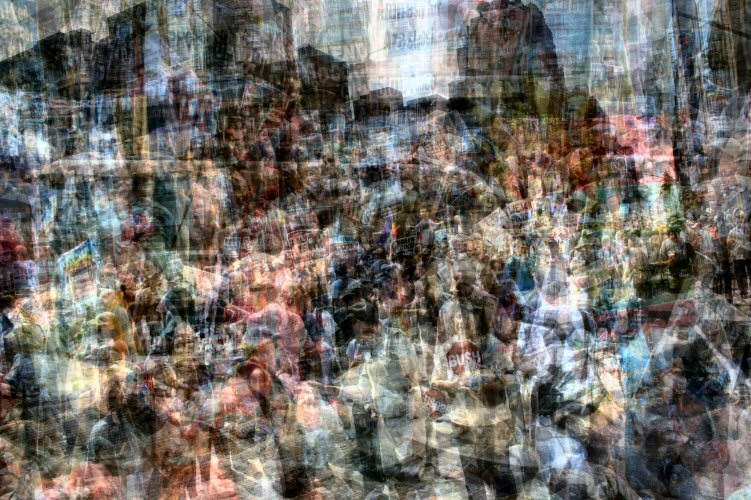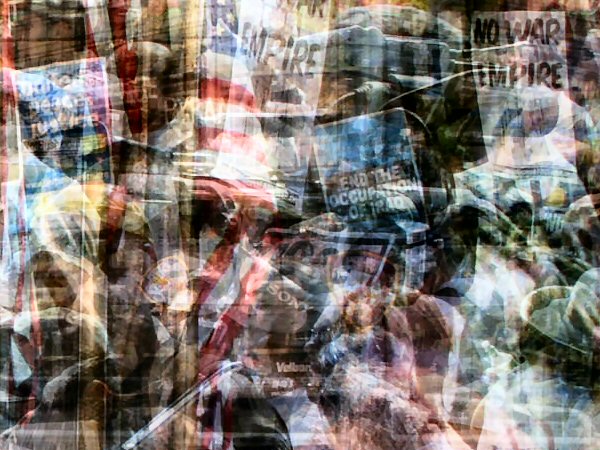Please wait a few moments while we process your request

Jim Campbell
Representing Simultaneous Images
The Daniel Langlois Foundation is supporting the development of a body of work that will expand the possibilities for juxtaposing and sequencing video images. This work will showcase the findings of advanced research and assist in the creation of dialectic images in which strata of time and space coexist.
Keying is a technique for overlaying several video sources onto the same image. Since the late seventies, this formal strategy has become commonplace in videomaking. In his project, Jim Campbell will avoid signal losses that usually affect the readability of elements juxtaposed in an electronic collage. Representing Simultaneous Images isn't the artist's first foray into overlay techniques in video. Ruins of Light (1992) and Simultaneous Perspectives (1997) shown at the 1997 ICC biennial (1) both experimented with this procedure.
Like these past works, Campbell's two new installations will contain software that manages video sources in real time. The first installation will display a series of video images captured live on the exhibition site. The layered image generated by this procedure will combine a series of disparate micro-events. Architectural elements will merge with visitors to the gallery and passersby outside. The accumulating layers of images will produce an impossible snapshot, a sort of synthesis of the elements in the environment at a given moment in time.
The second work will draw on the same procedure, juxtaposing a series of video sources in a single image. Here, however, the images will come from a database, and specific parameters will control their sequence. Each video source will be associated with a series of keyword descriptors, along with time parameters such as the hour of the day or the season of the year. Controlling the juxtaposition and sequence of images will produce poetic resonance while avoiding repetitiveness and randomness. Campbell, who once again is emphasizing the dialectic nature of his work, plans to juxtapose video images shot in natural and industrial sites (the Sierra Nevada Mountains and the city of Los Angeles). At both sites, the images will be gathered at different times of the year and under different weather conditions.
While refining the HD equipment needed to display these works, Campbell created fixed images that were initially intended as studies for the videographic installations. At this stage of his research he was seeking the accurate dimensions of the image, complex due to its multi-layering, which are crucial to the act of perception, and his studies allowed him to determine the correct proportions. In fact, the superimposition used as a composition method tended to render the image abstract to the point that it was necessary to get closer to see and interpret the myriad details and fragments comprising it before finally reaching an “understanding” of its totality and making sense of it. In other words, according to the artist, this strategy allowed him to refrain from assigning a predetermined meaning to the image, permitting spectators instead to imagine their own narration. And while these studies seem to indicate a new direction in the artist’s practice, they are actually in keeping with his preoccupation with the perception threshold and its effects on memory and the imagination.
At once, the pictorial reference – supported by the use of light boxes as presentation mode – is strong and leans particularly towards futurism. We know that in creating their paintings, futurists favoured superimposition to the collages preferred by cubists. In the same way, objects in Campbell’s newer works are neither isolated nor juxtaposed, but rather fuse into one another in multiple layers. In both futuristic paintings and the new works by Campbell, one discovers conflict and dissonance among the colours, “lines of force,” an intersection of planes and concurrent points of view. Another link to futurism can be found in the title of the works themselves: Political Protest New York 2004 (2005) (all of the photos used in the composition of the works were taken during a protest in New York). The reference to politics is literal – much like Interventionist Demonstration (1914) by Carlo Carrà – and indicates a concern for the social issues of the era, without, of course, espousing the ideology championed by futurists. Finally, what allows such a comparison is a common desire to grab the attention of spectators and thrust them into a dynamic experience defined by flux and instability, which addresses both perception and memory.
Like these past works, Campbell's two new installations will contain software that manages video sources in real time. The first installation will display a series of video images captured live on the exhibition site. The layered image generated by this procedure will combine a series of disparate micro-events. Architectural elements will merge with visitors to the gallery and passersby outside. The accumulating layers of images will produce an impossible snapshot, a sort of synthesis of the elements in the environment at a given moment in time.
The second work will draw on the same procedure, juxtaposing a series of video sources in a single image. Here, however, the images will come from a database, and specific parameters will control their sequence. Each video source will be associated with a series of keyword descriptors, along with time parameters such as the hour of the day or the season of the year. Controlling the juxtaposition and sequence of images will produce poetic resonance while avoiding repetitiveness and randomness. Campbell, who once again is emphasizing the dialectic nature of his work, plans to juxtapose video images shot in natural and industrial sites (the Sierra Nevada Mountains and the city of Los Angeles). At both sites, the images will be gathered at different times of the year and under different weather conditions.
While refining the HD equipment needed to display these works, Campbell created fixed images that were initially intended as studies for the videographic installations. At this stage of his research he was seeking the accurate dimensions of the image, complex due to its multi-layering, which are crucial to the act of perception, and his studies allowed him to determine the correct proportions. In fact, the superimposition used as a composition method tended to render the image abstract to the point that it was necessary to get closer to see and interpret the myriad details and fragments comprising it before finally reaching an “understanding” of its totality and making sense of it. In other words, according to the artist, this strategy allowed him to refrain from assigning a predetermined meaning to the image, permitting spectators instead to imagine their own narration. And while these studies seem to indicate a new direction in the artist’s practice, they are actually in keeping with his preoccupation with the perception threshold and its effects on memory and the imagination.
At once, the pictorial reference – supported by the use of light boxes as presentation mode – is strong and leans particularly towards futurism. We know that in creating their paintings, futurists favoured superimposition to the collages preferred by cubists. In the same way, objects in Campbell’s newer works are neither isolated nor juxtaposed, but rather fuse into one another in multiple layers. In both futuristic paintings and the new works by Campbell, one discovers conflict and dissonance among the colours, “lines of force,” an intersection of planes and concurrent points of view. Another link to futurism can be found in the title of the works themselves: Political Protest New York 2004 (2005) (all of the photos used in the composition of the works were taken during a protest in New York). The reference to politics is literal – much like Interventionist Demonstration (1914) by Carlo Carrà – and indicates a concern for the social issues of the era, without, of course, espousing the ideology championed by futurists. Finally, what allows such a comparison is a common desire to grab the attention of spectators and thrust them into a dynamic experience defined by flux and instability, which addresses both perception and memory.
Vincen Bonin, Jacques Perron © 2005 FDL
(1) NTT InterCommunication Center (ICC): http://www.ntticc.or.jp/calendar/1997/icc_biennale97/works/
Related pages:
 Jim Campbell
Jim CampbellOriginally a filmmaker, Campbell turned to science after having worked for several years on a personally difficult film on mental illness.
 Jim Campbell, Explorations of Meaning in Quantized Information
Jim Campbell, Explorations of Meaning in Quantized InformationJim Campbell explores visual and poetic meaning in the small amounts of digital information that make up conventional digital representation.
External link:
Jim Campbell:
http://www.jimcampbell.tv/
http://www.jimcampbell.tv/













